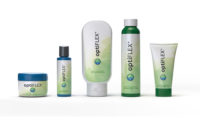Eco-Friendly Adhesives for Converting and Packaging
Starch-based adhesives offer a number of benefits in converting and packaging applications.



The bioproducts business is built upon taking naturally derived products and either replacing or extending synthetics with equal or better-performing components.



Packagers and converters are always seeking the most efficient, cost-effective adhesives. Many times, synthetics are not the most reliable solutions. This is especially true in an era when U.S. companies of all types are encouraged to find more environmentally friendly options.
Modern technology has allowed “green” choices to become increasingly sensible both for environmental and economic reasons. While ingredients are constantly advancing, eco-friendly adhesives are not new. The Adhesive and Sealant Council (ASC) uses a table1 to show the evolution of adhesives used in packaging and converting applications from the 1920s on, marking the initial era as one classified by Band-Aid® as the first pressure-sensitive adhesive. The timeline’s list of changes expands with each decade—from VAE-based emulsion to recyclable hot melts and shrink labeling. As the chart concludes with the 2000s, we are left with just two new movements: reduced application temperature hot melts and increased emphasis on sustainable adhesives.
Sticking with Starch
Sustainable options include biopolymers, as well as biodegradable and recyclable adhesives. But what makes these alternatives attractive? Can they perform as well as synthetics?
Let’s consider hydrophilic starch-based adhesives, which experts have continuously improved upon since their introduction. Today, starch-based adhesives rival the performance of synthetics by:
• Using natural, renewable, recyclable and biodegradable resources
• Offering multiple tack levels for various applications
• Allowing customization to adjust percent of solids, viscosity and molecular weight to meet exact needs
• Costing less compared to synthetic alternatives
• Offering excellent batch-to-batch consistency
• Having a high binding strength
• Allowing for comprehensive, chemical-free cleanup
Starch-based adhesives are also more easily recycled, leaving behind little to no residue when sent through a paper factory’s recycling machinery, compared to synthetic adhesives. This allows users to sell or reprocess trim and waste, along with the product at its end of life.
Some of the industry’s most reliable starch-based adhesive manufacturers have increased products’ stability and shelf life when compared to dextrin-based materials, while simultaneously offering more varying “tack” levels than synthetics. Tack refers to the time required for the adhesive to set, allowing for open time to adjust the position of the materials being bonded. Open time refers to the amount of time it takes to make a bond during which a surface retains its tack; the lower the tack, the more open time. This window can range from mere seconds for fast-setting adhesives to minutes and, in some cases, hours. Starch-based adhesives generally have longer open time; that increased time offers laminators the ability to position or reposition the coated materials without fiber tear from the adhesive strike-in.
Extended open time is a characteristic of many starch-based adhesives. This makes them a top choice for litho-laminating applications, where machine operators need to reposition top liner sheets to corrugated box substrates prior to adhesive setting and drying. Projects that involve dry end use often have the best success with starch-based alternatives.
Packaging and converting applications must deal with not only evolving adhesives, but also ever-changing product materials. Various attributes, including lay-flat performance, tack and strength, affect which projects will be the most ideal fits for starch-based adhesive use. Among the most ideal applications are porous substrates, such as paper-to-paper laminations and the glued lap joints of corrugated containers. The more porous the substrates, the better the ability of a starch-based adhesive to strike-in and bond in the z-direction.
Eliminating Messy Cleanup
Easy cleanup is a concern in U.S. packaging and converting environments; starch-based adhesives can ease the cleanup process of manufacturing equipment. Most often, simply wiping down the equipment with water is effective, largely because starch-based products are hydrophilic in nature. Conversely, synthetic adhesives may require laminators to scrape or use solvents to rid their equipment of dried adhesive.
In some cases—especially when it comes to smaller applications—laminators may not dispose of the pans and materials used during synthetic adhesive applications. Operators running smaller-scale manufacturing processes often prefer starch-based adhesives for that reason. Since they are chemical free, operators may either cover pots with a plastic wrap or apply a thin layer of water to hold the adhesive until the next morning. Water-based adhesives will not “skin” or dry out as easily as most synthetics.
Ungluing Misconceptions
Brands and marketers seeking more ways to address their corporate sustainability goals and make environmental or “green” claims look to naturally derived products instead of synthetics. In order to thrive, bioproducts suppliers must overcome a common misconception: that sustainable packaging materials are not as functionally effective as synthetic products.
Improved technology means that converting and packaging companies, as well as the industry as a whole, no longer have to sacrifice performance to use sustainable adhesives or materials. The bioproducts business is built upon taking naturally derived products and either replacing or extending synthetics with equal or better-performing components.
Many manufacturers offer a range of formulations that allow for variations in dimensional stability and tack, thereby enabling the ability to select a formulation created specifically for a particular application or customized formulation.
Moving forward, the packaging industry will continue to evolve with customer and environmental mandates. Converting and packaging professionals will continue to weigh the costs and benefits of all materials used to produce their products, with an end goal to avoid compromising quality while simultaneously maximizing sustainability.
For more information, visit www.penford.com/bioproducts.
Reference
1. “The Evolution of Adhesives Used in Packaging & Converting Applications,” The Adhesive and Sealant Council, www.adhesives.org/docs/default-document-library/evolution_of_packagingadhesives.pdf?sfvrsn=0.
Looking for a reprint of this article?
From high-res PDFs to custom plaques, order your copy today!








